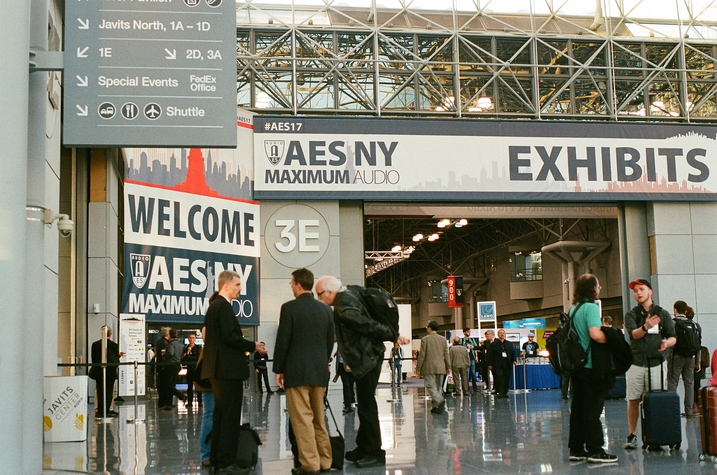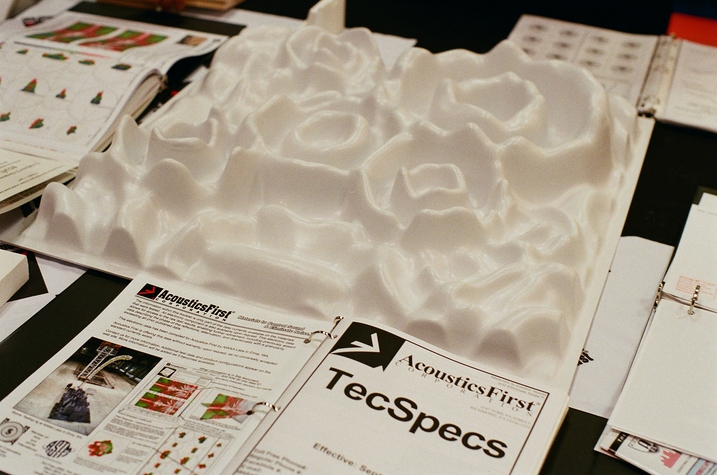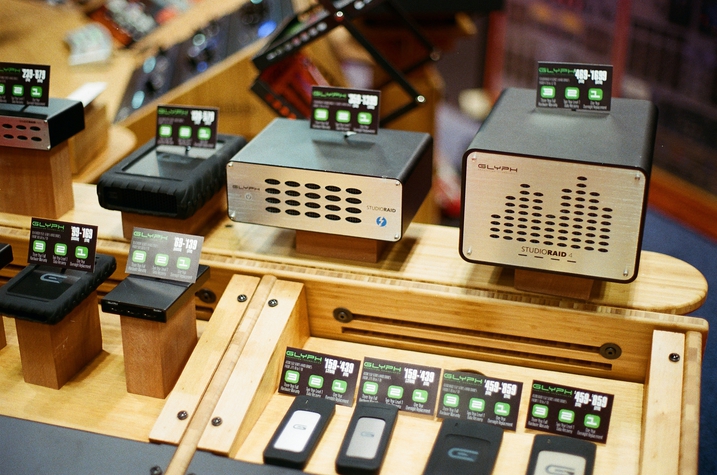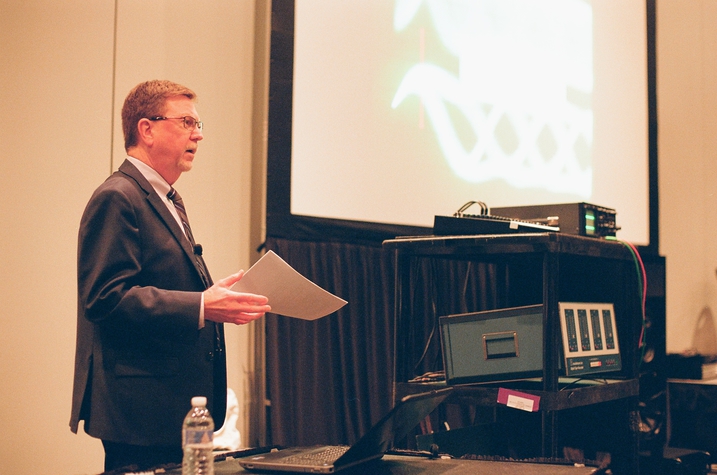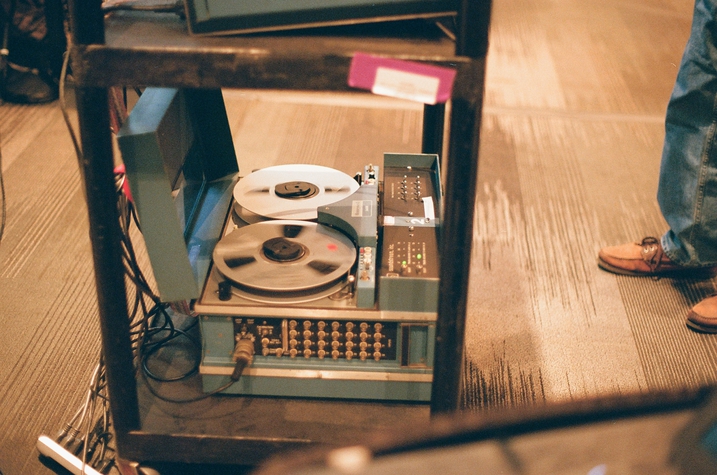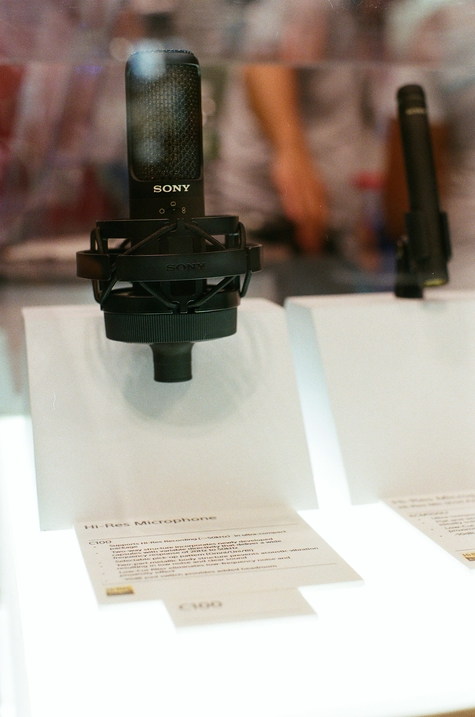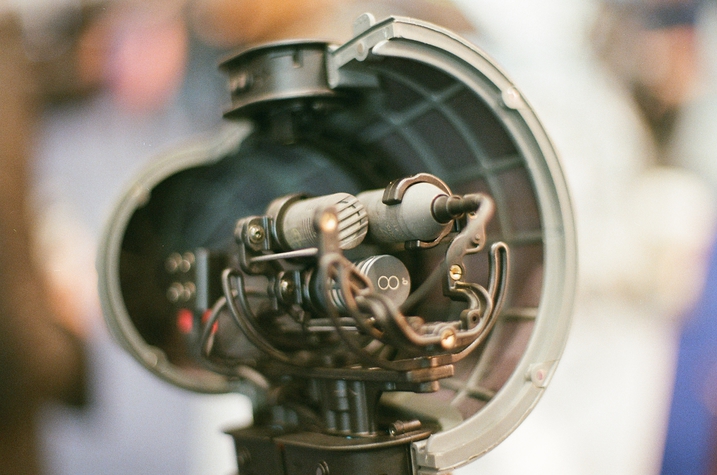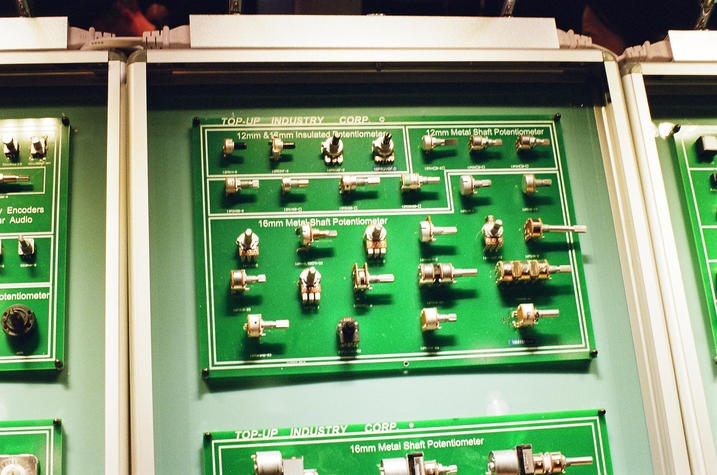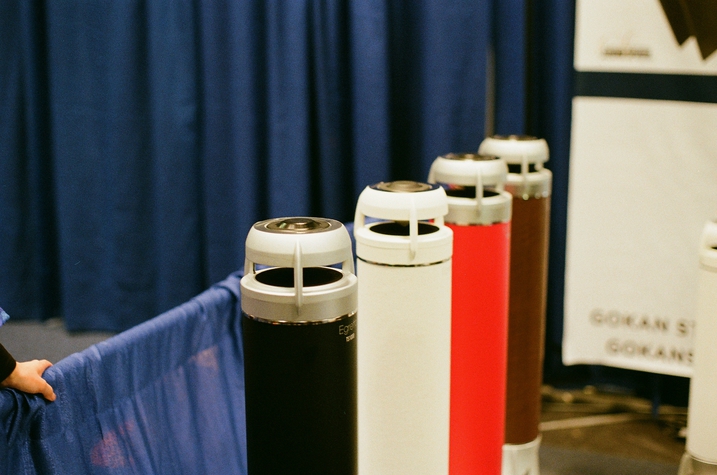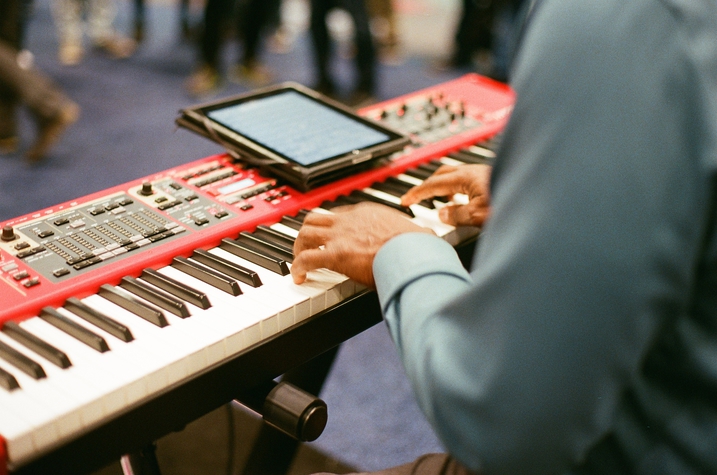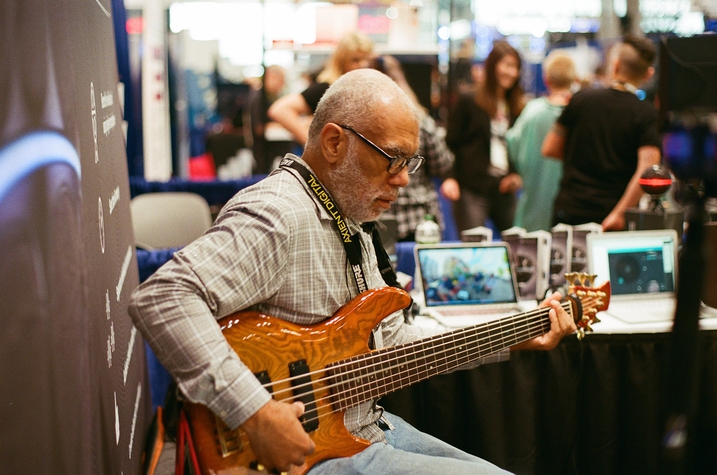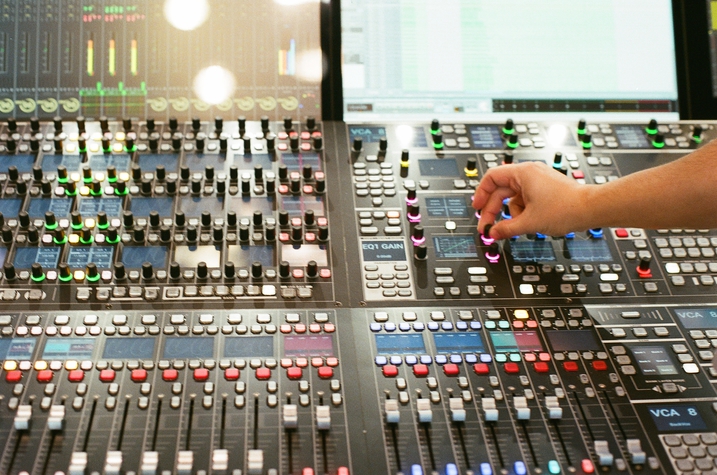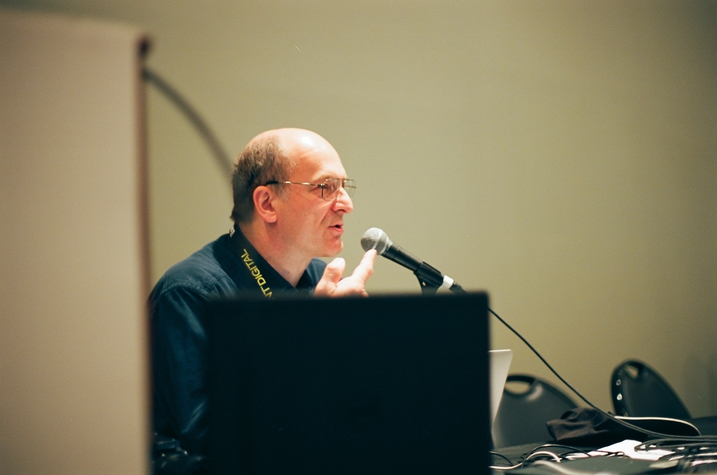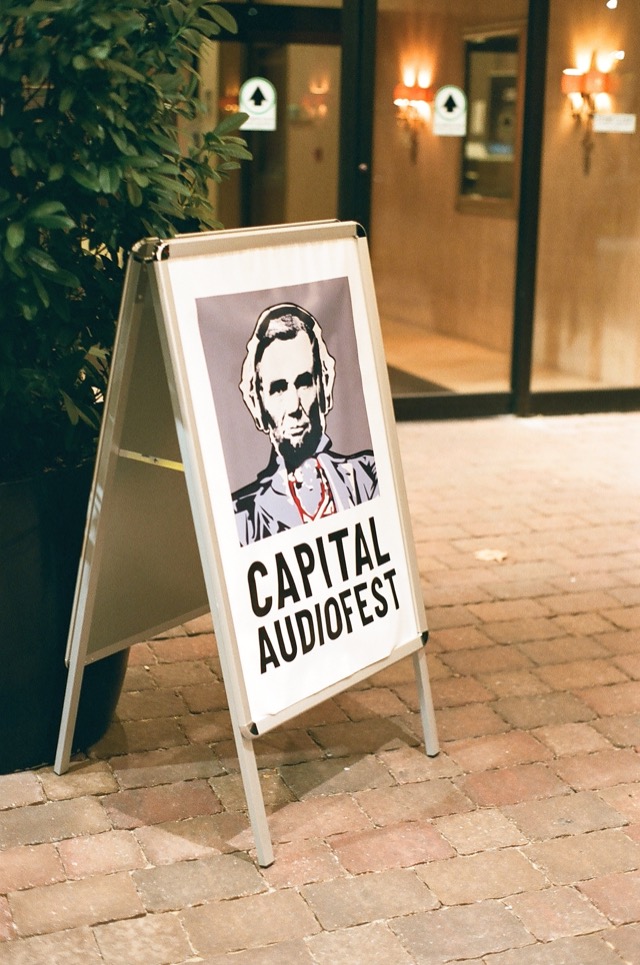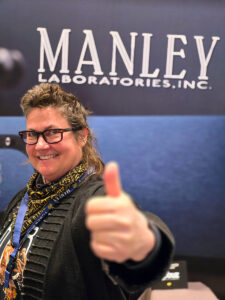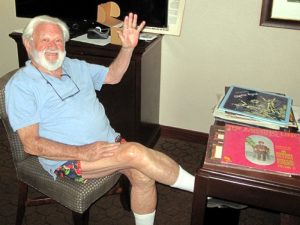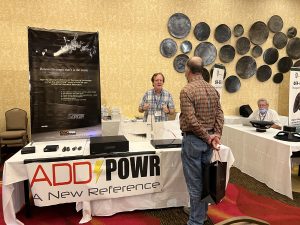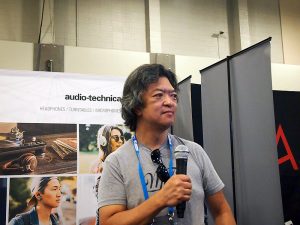Intro
The Audio Engineering Society convention is two different things happening at the same time. First of all there's a scientific conference downstairs with papers on the latest in audio technology. Secondly it's also a trade show selling pro audio gear. Both of these have many items that are of interest to the high end audio world or which will affect the high end world in the future.
This year the show was a little different because of attempts to integrate with some of the other shows in the industry and similar industries. First of all, the National Association of Broadcasters show was taking place in the same convention center, and a ticket to either one would allow you admission to both. The NAB show when I was a kid had a huge presence from the radio industry, but these days it seems to be mostly television. Still, there was a good interaction between the two groups of people and I'll talk a little about that throughout this report.
In addition, NAMM, the National Association of Music Manufacturers, has a huge trade show oriented toward music stores which some people view as a kind of competition for the AES show even though the markets are kind of distinct. This year, AES and NAMM are getting together with a set of pro audio symposia at AES that are sponsored by NAMM, and the NAMM show in January will have a small set of symposia sponsored by the AES. Bringing diverse groups together like this cannot be a bad thing, and in some ways it's really what the AES was founded for.
So, really it's four kinds of things under one roof and that's an awful lot to report on. So I will just list here some of the things I found to be interesting and which I think the high end world might find interesting too.
Cables
Lots of companies this year were selling bulk cable of a grade worth using for serious interconnects.
Gotham Audio is a Swiss company that has been manufacturing cable since 1976 when they took over the German EMT cable designs that were being used by Neumann and many other manufacturers. A large number of their cables have been resold into the audiophile market under various names and with substantial markup. If you are interested in well made cable exotica at reasonable prices I strongly suggest looking at their product. They were showing a variety of cables including the GAC-4 Ultra Pro microphone cable which employs a double wrapped shield plus an aluminum-impregnated-fibre shield with a star quad arrangement of two pairs wired out of phase to cancel out noise common to both pairs. Very well made precision material.
Sommer Cable, another big industrial European manufacturer, was there with some interesting materials including some newer CAT6e designs for general purpose data transfer.
Belden was there selling their 8412P "Plenum microphone cable." This is a teflon-insulated two-conductor cable with internal strength members. It is likely a variation on a constant-impedance military cable that they adapted for microphone use but it's less expensive than any of those constant-impedance cables. This is a very, very promising design for any kind of audio interconnects, balanced or unbalanced, and the teflon and rigid construction as well as low capacitance make it a good choice for low level signals. I guarantee you will see this cable appearing at the audiophile shows under various resellers' names and with considerable reseller markup.
Canare, which also has made fine microphone cable for many years which has shown up as home audio interconnect, had a booth at the NAB show where they were talking about coaxial cables and camera cables and all manner of video cables, but sadly they didn't have anyone over on the AES side to talk about their materials.
Acoustical Stuff
Lots of companies were selling all kinds of acoustical treatments as always; good acoustics is really the key to good sound in any kind of room anywhere. A company called GIK Acoustics was showing off bass traps in a variety of interesting patterns and finishes to blend with any modern studio decor, as well as diffusion plates and all manner of general purpose gobos and baffles.
Acoustics First from Richmond VA always makes the show with their various lines of acoustical products. They sell a good line of sound aborbing and diffusing products as well as some cool-looking acoustic fabrics for absorbers and speaker grilles. What I didn't know before is that they also sold a variety of vibration control products too.
A company called Sondhus which has been doing studio design work in the past was entering the manufacturing world with a line of acoustic treatment products. They looked very fine although they had little real information available at the show.
And Listen Audio was showing off a whole new line of very cool-looking diffusers and absorbers as well. Having a variety of different devices from different manufacturers available to you means you can deal with both how the room sounds and how it looks almost independently.
John Calder gave a talk called New Research on Low-Frequency Absorption Using Membranes which was kind of heavier on the marketing than on the research but was still useful and informative. The membrane absorber is more broadband than a Helmholtz resonator but less broadband than a bass trap. It's a sealed resonant chamber with a membrane in front which results in more loss and a wider resonance than an open vented chamber. As such it's one more tool in the kit we have to deal with small room problems and the paper gave a good overview on the results of using them for lower frequency control. Preprint 9886.
I did see one thing over on the NAB show floor that is worth mentioning here. A company called Inter-America Stage Inc. is selling the SkyDeck, a grid of tensioned steel cables that form an acoustically and almost visually transparent floor for theatre installations. Rather than a narrow catwalk to access theatrical lighting, suspended microphones, and the like, this system provides a wide, solid, and easy to walk on grid, improving safety and appearance. My wife, after many years of working festivals, was very, very enthusiastic about this product and for good reason.
Digital Processing
If I were still doing awards, I'd give the best product in show award to the Exbox.MD from Direct Out Technologies. This is a little black box that takes an ethernet carrying Dante audio on one end and a coax cable carrying MADI audio on the other and translates from one to the other. Since MADI has become almost ubiquitous in studios and Dante almost ubiquitous in live sound systems, the ability to easily and conveniently translate is a big deal.
Brainstorm, a Belgian concern sold in the US by Plus24, was selling a precision reference clock with eight outputs and all sorts of synch options. Overkill for an audio playback system but not overkill at all for people having to integrate with video systems while keeping total audio jitter down.
Mutec, a German firm, was selling a simpler and smaller reference clock source, but still a very accurate one. They also had a line of other interesting digital audio products including their MC-6 format and sampling rate converter. Rate conversion is a nontrivial problem because of the need to compromise between filter latency and filter accuracy, and although they couldn't go into a lot of detail about the internal algorithm this is surely an improvement over the old Roland and AD1890-based devices that are still seen frequently in studios.
Tascam makes a bunch of high end portable recorders, most of which they didn't have at the show this year. I asked one of their salesmen and they said that the market for that gear was mostly at Hollywood as wasn't growing so they didn't feel like it was worth bringing to the show. They were showing the Tascam DA-3000 DSD master recorder, recording 2-tracks with a very high quality set of converters built in, but it didn't seem like people there really knew about it. That's a shame since this is one of the finest sounding standalone recorders today.
Analogue Processing
Once again everyone and his brother are showing API 500-series modules, and even API was at the show with them as well as with their consoles. Radial was showing a line of racks for these modules as well as their own line of various 500-series devices. They also had a thing they called the WM8 which was a small master section that you could use to turn your 500-series rack into a small stereo mixer.
Converters
Prism had their ADA-8XR digital interface, with eight A/D and 8 D/A modules and a variety of different I/O modules that you could plug in for different digital interfaces. Prism makes equipment designed to last many years and they keep supporting it, and the ability to make the digital end modular tends to make it more usable for longer as you can change out the interface as computer technology changes.
The archiving and restoration program brought in Paul Blakemore from the Concord Music Group, who carried with him one of the original Colossus audio recorders. These were 16-bit recorders designed by Stockham in the late 1970s which used a 1" digital instrumentation transport and custom converters and were used by Telarc extensively. He played back the master tape of the original Telarc 1812 recording which sounded remarkably good for early digital recording (and much better than the Telarc CD). It was a fascinating presentation and a look into some of the constraints and compromises in digital recording back in the early days.
Microphones
Sony was showing their new C100 condenser microphone. This is a two-way microphone with a main capsule and a high frequency capsule, and a crossover between the two at 25kHz. While I am a little skeptical about ultrasonic response being desirable for microphones, a lot of people in Japan are very enthusiastic about extended high frequency response and if you want it, this is the correct way to get it. Some other microphones have done this, with crossover points at lower frequencies that created aberrations below 20kHz that were clearly audible. Others have taken their standard capsules and equalized internally, resulting in flat ultrasonic response at the expense of tremendous ultrasonic noise. This is the smart way to do it and this is one of the first exciting microphones to come out of Sony in years.
Mark Fouxman from Samar Audio Design was showing off some new condenser microphones that he is adding to a long line of beautifully made precision ribbon microphones. But what was most interesting is that he had some very small sorbothane pucks with cups on top, for mounting microphone stands on to reduce conducted vibration into the stands. Very cool gadgets for field recording when the isolation mounts just aren't enough.
A company from Poland called Zylia was selling a microphone array, a small ball with a number of transducers around it. By recording the array as a discrete multichannel recording, they can in post-production later on adjust the microphone pattern. What is unique about this is the application they are looking at, because they are talking about putting the microphone in front of a group of musicians and extracting multiple outputs with different derived patterns, one pointed at each musician. It's an interesting and strange way to make a one-microphone recording. I am a little skeptical of the ability to get tight control with only 19 channels, but it was hard to tell under show conditions. Definitely worth checking out in a better listening environment.
Not a lot of papers this year about microphones, although John Vanderkooy had an interesting paper called Loudspeakers as Microphones for Infrasound in which he described very low frequency microphones built with loudspeakers. The idea isn't new, but he did a good job of showing the math to both describe the system response and the noise analysis. Preprint 9856.
Another paper related to microphones was Development and application of a stereophonic multichannel recording technique for 3D Audio and VR by Helmut Wittek and Guenther Theile. They propose an array of eight supercardioid microphones which can give signals that can be integrated into an object oriented audio mix. It gives good imaging up front and in the rear, height and depth cues, and good stability. Preprint 9869 (even though the paper does not say that on the top).
Components
Probably most interesting for the high end crowd are some of the new silver wound transformers from Lundahl in Sweden. Some of their smaller tube amp output tranformers and interstage transformers are now available with silver wire as an option. Performance is a slight improvement over the already excellent Lundahl transformers, due to the lower series resistance.
Another thing that will be of great interest to the high end community is a line of thin film chip resistors specifically aimed at the audiophile market, sold by Susumu International and available through Digi-Key. Susumu claims lower excess noise than competing resistor designs and lower than their standard through hole types. Worth checking out for collector resistors on high gain phono preamps and similar applications.
Electroswitch makes some very fine and solid switches, and they were showing them off at the show. What I had never seen before was their MM Series of rotary encoders, in part because the cool thing about them is something they aren't promoting. These can be ordered as simple 12-position rotary switches instead of encoders, and they can be ordered with a hollow center shaft so that a pushbutton can be put in the middle of your knob. But, that center shaft can ALSO be used to mount a potentiometer for a convenient and easy concentric switch/pot combination, something you very seldom see today.
This year we also had a Taiwanese manufacturer showing switches and pots at the show. Top-Up Industry Corp had a very wide range including some concentric pots that didn't look any worse than anyone else's. As older style controls like pots and rotary switches become more rare, finding any sources at all for these items becomes more and more important. They also do faders.
There have been attempts to model vacuum tubes in the SPICE circuit design package since Marshall Leach's work in the mid-nineties. In Unified modeling for series of miniature twin triode, Shiori Oshimo and others from the CS department of the Hiroshima Institute of technology attempt to produce a unified model that can effectively model the behaviour of the 12AX7, 12AU7, 12AY7, and 12AT7 by changing various internal parameters to match the device geometry. The presentation and paper are a bit tough going due to language issues but the ideas are not terrible. Preprint 9851.
Hearing
In An Acoustic Study of Airbag Deployment in Vehicles, John Vanderkooy and Keven Krauel measured the various sounds and air pressures in two different automobiles with airbags throughout detonated remotely. They measured at the points where the driver's ears would be as well as at some reference locations, and found up to 47,000 pascals of pressure during the peak impulse. Some discussion was made about the behaviour of the ear with very high peak pressures of short duration. This was useful work that now needs correlation with actual models of hearing damage. Preprint 9898.
Listening For Distortion
James Larson presented a short educational presentation, written with Gene DellaSala and Don Keele Jr. called A Tutorial on the Audibility of Loudspeaker Distortion at Bass Frequencies. He talked about the various symptoms of linear and nonlinear distortion on the waveform and the relative audibility of each of them, with references to the many years of research on distortion audibility. A good overview on what is important for woofer design and what isn't. E-Brief 378.
All of this research is followed on in Perceptual Assessment of Headphone Distortion by Louis Fielder from Dolby. He takes a model made from within Dolby that was created by presenting listeners with pure tones at frequencies from 20 to 500Hz and tests listeners for the degree to which other tones are masked by the primary frequency. He then applies this to testing of headphones, where pure tones are applied to headphones and then the degree to which the resulting distortion products would be masked by the original tones are measured. There is some discussion about expanding this method to loudspeakers and other comparatively high-distortion transducers. Preprint 9841.
Not a typical paper about distortion but in some ways about evaluation of a new kind of distortion was Perceptual Evaluation of Source Separation for Remixing Music by Hagen Wiersdorf and others at the University of Surry in England. There are a number of "blind source separation" algorithms out there that can in theory isolate one sound source from a mix, and really it's a difficult problem and really they don't work very well. So the question becomes, if you isolate one sound source and then mix it back in to increase or decrease the level of one sound source in a mix, how much can you get away with before the artifacts become audible? The authors found that with the five separation algorithms tested they could boost the vocal levels by as much as 6dB before the artifacts became audible, even when those artifacts were painfully obvious with the "separated vocal" track being listened to in isolation. As new techniques and new algorithms are developed, new listening tests and new ways of conducting listening tests become important and this is one of them. Preprint 9880.
There has been a lot of interest in Japan about how audible different CD pressing materials are. In Study on objective evaluation technique for small differences of sound quality, Yuki Fuguda and others played back a conventional pressed CD and a special photopolymer dics called the UHQCD. Even though the data on the discs was the same, they found small but repeatable audio differences on playback and measurable differences in recordings made off the CD player analogue line outputs. This is an interesting result but from my perspective any difference is due to deficiencies in the CD player's ability to properly read and reconstruct the audio. The authors do not provide any information on what CD player was used and this test would be far more useful if it were performed with multiple players. Preprint 9817.
Sound Reinforcement
After many years without many SR products vendors, the AES is improving a lot in that regard. This year there was a demo room from L'Acoustics, the big French company that re-invented the line array, but we also had a big demo room from KV2 Audio. KV2 is a Czech company making some very clean line array speakers as well as some smaller speakers for sound reinforcement. They were also showing off some DI boxes and other small problem solving gadgets, but the big deal was the speaker systems which were clean and dry.
Flat-panel loudspeakers made with a stiff but flexible panel with a driver to make them flex have been used for a number of applications where high fidelity isn't needed but concealability is important. In Impulse and Radiation Field Measurements for Single Exciter versus Exciter Array Flat Panel Loudspeakers, David Anderson and others from the University of Rochester attempted to expand this with multiple driven elements in order to reduce some of the inherent resonance problems. The results are not high fidelity but are a considerable improvement with little added cost. E-Brief 379.
Monitor Speakers
Dynaudio was showing their LVD7 small reference monitors, but they were also showing some larger studio monitors with the slogan "Low Volume Precision." It is ALWAYS good seeing people promoting listening at lower volumes, and the Dynaudio speakers are in fact designed to be accurate at lower levels unlike some of the big soffit-mounted monitors that we grew up with.
A new company called APS for Audio Pro Solutions was also showing off a few smaller monitors, the Trinity, Aeon, and Coax monitors. All of them looked well made and promising.
In the past decade or so, infinite baffle loudspeakers have been increasingly popular in the high end market, partly because modern long-excursion drivers make them usable down at frequencies where they become inefficient. For the first time ever, though, I saw at the show an infinite baffle studio monitor. Reflector Audio was showing a four-woofer array with a horn-loaded compression driver this year, and they had a listening event at a local studio that I was unfortunately unable to attend. After many years of discounting infinite baffle systems, I am intrigued to see this become a usable technology again with advancements in drivers making it possible.
A new company called Gokan was also selling an unusual speaker that is really more aimed at the high end home market. It's a Heil AMT driver facing upwards into a baffle to produce an omnidirectional radiation pattern in the vertical plane. A curious idea, and of course on the show floor it was impossible to hear how it sounded but they have a showroom in Brooklyn.
Genelec, the Finnish firm that has long made quality studio monitors, was showing a redesign of their older classic 1032 monitor which was discontinued some years ago when their whole line was upgraded. The new 1032C is electronically and mechanically very different but designed to sound and behave very much like the old classic.
Downstairs in the papers sessions, Steven C. Thompson and Daniel M. Warren were talking on an Analog circuit model for loudspeakers including eddy current behavior and suitable for time domain simulation. It has long been common to use electrical analogies to describe mechanical systems, and the authors show two ways of modelling the distortion in loudspeakers caused by eddy currents flowing through the magnet, currents induced by the change in magnetic field by the operation of the speaker. Both of these are older models from Leach and Vanderkooy but the authors compare them and give an ingenious easier-to-calculate solution for one of them. Preprint 9826.
Loudness
In Alternative weighting filters for multitrack programme loudness measurement, Steven Fenton and Hyunkook Lee from the University of Huddersfield in the UK used the increasingly popular BS.1770 "K-weighted" method to evaluate individual tracks from a multitrack mix and found the method did not work as well for isolated instrument tracks as it did on the overall mix. They proposed and tested two alternative filters that perform better under those circumstances. Preprint 9818.
Eelco Grimm and other panelists sat in talking about Loudness Issues in Cinema - Is the Reference Lost. They talked about how better sound systems caused louder movies and that caused audience complaints and that caused exhibitors to reduce reference levels. But I think in great part they missed the whole point that it's dialogue intelligibility that is causing the problems and that it's mixing style and environment that is causing the dialogue intelligibility.
Testing And Listening
Gregord Schmidle, Gerd Koeck, and Brian MacMillen gave a paper on Objective testing of high-end audio systems that was really a good introduction to doing quality control and basic end to end tests of small production items. Not necessarily limited to the high end market but it's a nice overview for people moving from making a few items in their garage into making a few more on a small production basis as it common in the high-end industry. Preprint 9835.
On the other hand, Thomas Lund and Aki Makivirta from Genelec talked On the Bandwidth of Human Perception and its Implications for Pro Audio. This was an interesting if vague philosophical diversion and the published paper does not do the talk justice. The authors talked about the philosophy of listening and the kinds of listening and about some basic sensation and perception research. There is nothing innovative here but there is an interesting set of references and some discussion about the nature of listening. Preprint 9882.
Headphones
Another interesting one turns out to have a lot of relevance to the current high-end community. If you want to make perceptual tests on the auditory system using headphones, you need very precise matching between sides of the headphone in order that the imaging effects of the headphones not interfere with the test. In Relevance of Headphone Characteristics in Binaural Listening Experiments: A Case Study, Florian Voelk and others test headphones with artificial ears and find that even with that comparatively consistent method that inter-ear differences are substantial and well greater than estimated experimental error. The test methodology is of interest to anyone designing or evaluating headphones. Preprint 9894.
Now, on the opposite side, if you want to take a recording that contains discrete signals from different locations and transform it into something that sounds correct in headphones, you need to know the listener's specific head-related transform function, which is specific to the shape of their head and ears. You can use a generic one but it's never as accurate as one specifically measured from the listener. The problem is that conventional methods of measurement are difficult and require very controlled conditions. Jonas Reijniers and others from the University of Antwerp found a very ingenious way of measuring this in a normal home environment, using a single signal source and in-ear microphones and moving the listener's head instead of the sound source. The process seems simple, effective, and elegant. The title is DIY Measurement of Your Personal HRTF at Home: Low-Cost, Fast and Validated. Convention E-Brief 399.
The Japanese audio community is very interested in being able to accurately reproduce ultrasonics, and in A Headphone Measurement System Covers Both Audible Frequency and beyond 20kHz, Naotaka Tsunoda and others from Sony discussed the difficulty of extending headphone measurement methods to 40kHz. I am a little skeptical of this work owing to the difficulty of even meausuring accurately up to 8kHz and the major changes caused by tiny headphone position differences, but if you are interested in methods of reproducing very high frequencies you might check this out. Preprint 9873. This paper is also available freely online as an open access document.
Another interesting headphone paper is on the other end of the spectrum. Elisabeth McMullin from Samsung talked on A Study of Listener Bass and Loudness Preferences over Loudspeakers and Headphones in which listeners were asked to adjust level and bass to taste. They consistently set them both higher when using headphones (equalized flat using a standard artificial ear) than when using speakers. The author theorizes that this might be due to deficiencies in the standard artificial ear. Everyone agreed that there was greater difficulty and poorer consistency making the level and bass decisions on headphones. Preprint 9855. This paper is also freely open online as an open access document.
Some similar research had been used by the folks at Harman International when they came up with a "target response curve" for in-ear phones, which presumably is close to what listeners feel is the ideal response curve. The problem with in-ear phones is that they are difficult to measure in the ear itself, and so it's hard to really know if the system is flat or not. All you can do is decide on a target response into a tube replicating the ear canal, and then hope for the best. In A Statistical Model That Predicts Listeners' Preference Ratings if In-Ear Headhones, a two-part paper, Sean Olive and others from Harman attempted to validate that target response through listening tests. They provided listeners with a wide variety of equalized sounds through phones which modelled different common earphones, but included examples of the target response in the process. Interestingly they found very similar responses from experienced and inexperienced listeners and found the measured frequency response was generally a good indicator of the perceived quality. The greater the response diverged from the target response, the less it was preferred by listeners. Now the key is to find if there is physiological basis for the target response being preferred. Preprints 9840 and 9878.
Concert Sound
There's nothing worse at a quiet concert of acoustical music than someone coughing loudly right behind you. Unless, it's someone unwrapping loud crinkly cough drops in an attempt to keep from coughing. In Influence of audience noises on the classical music perception on the example of anti-caught candies unwrapping noise, Adam Pilch and others from the AGH University of Science and Technology in Cracow measured the frequency emission of various brands of candies being crinkled and compared it with the spectrum of various classical concert recordings in order to determine which cough drops were more likely to be masked by the sound of the orchestra, as well as doing some measurements on loudness and noise character. Although this experiment still lacked a good perceptual model of annoyance, it was still a valuable and useful example that provides useful information. Who would have known that Ricola wrappers were the most loud? Convention E-Brief 361.
Press
There are always some interesting press folks showing off magazines aimed at various niches of the audio industry, some of them small indeed. Recording Magazine and their Spanish-language sister publication, Musico Pro, actively had a booth and were promoting their magazine aimed at recording musicians. Tape Op, a very worthwhile free magazine aimed at the indy recording market, had a booth. And Resolution, one of the last of the magazines for the studio market still left, didn't have a booth but had their latest issue out and reporters checking out the show.
I don't know where else to put this, but someone from puremoderation.com came to me to talk about their online content moderation services. Apparently they propose for American firms to outsource labour-intensive online moderation services to their firm in Vietnam. I cannot say anything one way or another about this practice.
The Society of Broadcast Engineers had a booth at the AES (and not at NAB for some reason), talking about SBE membership and why it's a good thing. The SBE provides standards and certifications for broadcast engineers, picking up the ball as the FCC relaxed regulations back in the 1990s. What I found interesting this time though was that they have a small press and also a bookstore selling a large number of books about RF and audio engineering to members at a discount.
Things
Another odd thing that I can't easily categorize is a device from the RecordME company. They have a standalone box that connects to the internet with two-way video conferencing combined with high quality A/D converters so that a concert can be recorded by remote engineers in a distant studio from feeds provided by the PA engineers, and so the remote crew and local crew can communicate together. It's an odd mix of technologies in one box but anything that promotes better concert recordings is worth looking at in my book.
Dan Mortensen from Seattle gave a presentation on the Columbia 30th st. studio where so many classic recordings from the fifties through the eighties were made. He dug up a huge amount of historical information both about the hall itself and the equipment used and how they changed over the years and it explained some of the things I have heard and seen in Columbia recordings over the decades. Some of this is supposed to become available online soon.
End
It was a worthwhile show full of the events that alter and illuminate our lives and also some decent audio gear. I highly recommend a visit to the show to anyone who is interested in what is happening in the audio production and concert world today, both good and bad.




